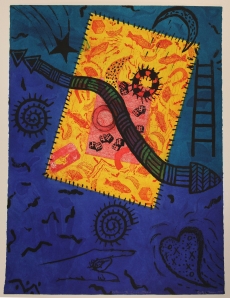Staff Pick: Betye Saar, Return to Dreamtime, 1990
August 19, 2014
In the current exhibition of Shared Vision: The Myron A. and Anne Jaffe Portenar Collection, the staff at the Arthur Ross Gallery and the Curator’s Office of the University of Pennsylvania have chosen a very special piece and has always been chosen to be discussed on tours! Come see this piece for yourself along with the other 62 pieces in the show now through October 12, 2014! Betye Saar (American, b. 1926)
Return to Dreamtime, 1990
Etching
Courtesy of the University of Pennsylvania Art Collection
Betye Saar, a Los Angeles native, is best known for her iconic assemblages such as The Liberation of Aunt Jemima (1972) and Black Girl’s Window (1969). Her artistic beginnings can be traced to the early 1960s when she studied design and printmaking at California State University at Long Beach. Over the years Saar often returned to her printmaking roots to create works that reflected her ongoing fascination with spirituality and mysticism.
Return to Dreamtime incorporates several fetishes that reoccur in Saar’s body of work: horseshoes, taro cards, dice, ladders, feathers, and lightning bolts. In this piece,
a vibrant square of yellow placed against otherworldly indigo sky references the artist’s ancestral ties to quiltmaking. Saar often borrows materials from different cultural systems. Being of mixed heritage herself – African, European, Native American – she juxtaposes these symbols in her work. For example, the heart may refer
to both the Haitian Vodun goddess as well as the sacred heart of Christ’s Passion, uniting Saar’s African and Christian European roots.
Return to Dreamtime incorporates several fetishes that reoccur in Saar’s body of work: horseshoes, taro cards, dice, ladders, feathers, and lightning bolts. In this piece,
a vibrant square of yellow placed against otherworldly indigo sky references the artist’s ancestral ties to quiltmaking. Saar often borrows materials from different cultural systems. Being of mixed heritage herself – African, European, Native American – she juxtaposes these symbols in her work. For example, the heart may refer
to both the Haitian Vodun goddess as well as the sacred heart of Christ’s Passion, uniting Saar’s African and Christian European roots.
Betye Saar (American, b. 1926)
Return to Dreamtime, 1990
Etching
Courtesy of the University of Pennsylvania Art Collection
Betye Saar, a Los Angeles native, is best known for her iconic assemblages such as The Liberation of Aunt Jemima (1972) and Black Girl’s Window (1969). Her artistic beginnings can be traced to the early 1960s when she studied design and printmaking at California State University at Long Beach. Over the years Saar often returned to her printmaking roots to create works that reflected her ongoing fascination with spirituality and mysticism.
Return to Dreamtime incorporates several fetishes that reoccur in Saar’s body of work: horseshoes, taro cards, dice, ladders, feathers, and lightning bolts. In this piece,
a vibrant square of yellow placed against otherworldly indigo sky references the artist’s ancestral ties to quiltmaking. Saar often borrows materials from different cultural systems. Being of mixed heritage herself – African, European, Native American – she juxtaposes these symbols in her work. For example, the heart may refer
to both the Haitian Vodun goddess as well as the sacred heart of Christ’s Passion, uniting Saar’s African and Christian European roots.
Return to Dreamtime incorporates several fetishes that reoccur in Saar’s body of work: horseshoes, taro cards, dice, ladders, feathers, and lightning bolts. In this piece,
a vibrant square of yellow placed against otherworldly indigo sky references the artist’s ancestral ties to quiltmaking. Saar often borrows materials from different cultural systems. Being of mixed heritage herself – African, European, Native American – she juxtaposes these symbols in her work. For example, the heart may refer
to both the Haitian Vodun goddess as well as the sacred heart of Christ’s Passion, uniting Saar’s African and Christian European roots.